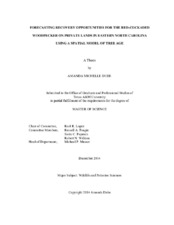| dc.description.abstract | Currently, recovery efforts for the federally endangered red-cockaded woodpecker (RCW; Picoides borealis) primarily occur on public lands throughout the Southeast, where proven management practices ensure availability of mature, open pine savannahs able to support populations. Many populations on public lands are approaching carrying capacity, suggesting RCW management on private lands will become increasingly important to achieve recovery goals. Recovery on private lands will involve developing recruitment clusters through management practices that produce sufficient quality and spatial aggregation of trees age 60 or older to provide nesting habitat, and trees age 30 or older to provide foraging habitat, as outlined in the U.S. Fish and Wildlife Service (USFWS) Recovery Plan. In this analysis, relationships between tree age, canopy height, and site index were applied to land cover, LiDAR-derived canopy height, and expected site index data in a geographic information system (GIS) to produce a tree age model for pines on private lands in eastern North Carolina. Modeling provided a means to spatially and temporally identify recovery opportunities over the next 10 to 40 years, predict locations for potential recruitment clusters within the next 10 years, and assess connectivity between potential recruitment clusters.
Depending on predominant species, modeling produced acceptable estimates for tree age and suitability timeframes for 69-95% and 85-92% of surveyed parcels, respectively, compared to expected age and suitability timeframes derived from field-collected diameter at breast height (DBH). Over 90% of existing RCW clusters on public lands were modeled to contain trees age 40 or older, suggesting age was underestimated in some cases. Results indicate almost 80% of existing pines will remain too young over the next 10 years to support RCW cavity trees. However, over 3,000 potential recruitment cluster sites were identified. These could contribute to increased carrying capacity by providing habitat for potential breeding groups, and create links between existing populations. The prevalence of young pines suggests more opportunities to create RCW recruitment clusters will become available over time with proper habitat and population management. Modeling such as done in this study can serve as a valuable conservation planning tool to guide recovery efforts over space and time. | en |


